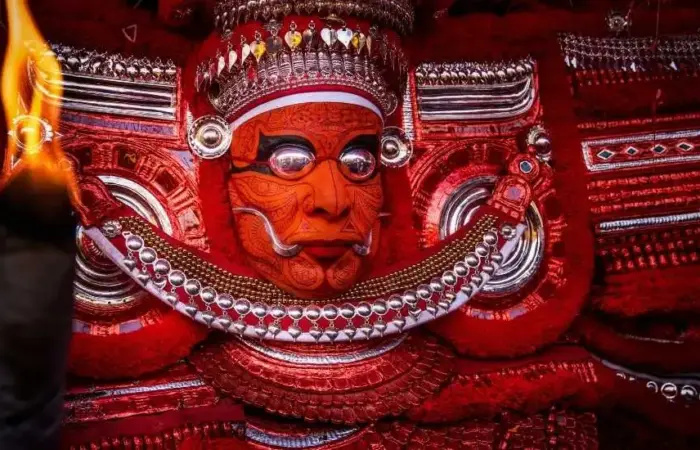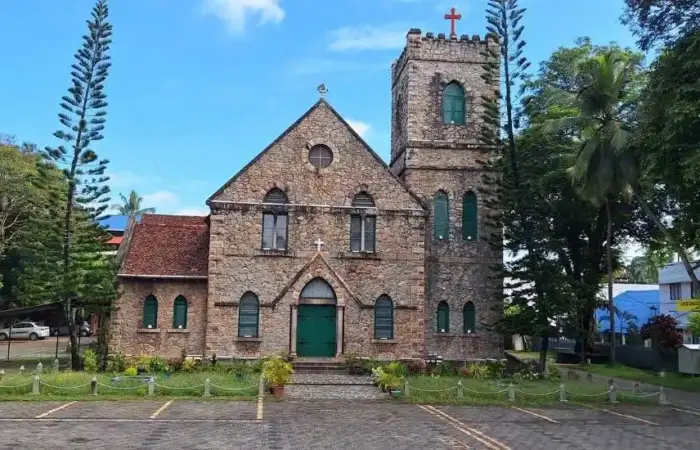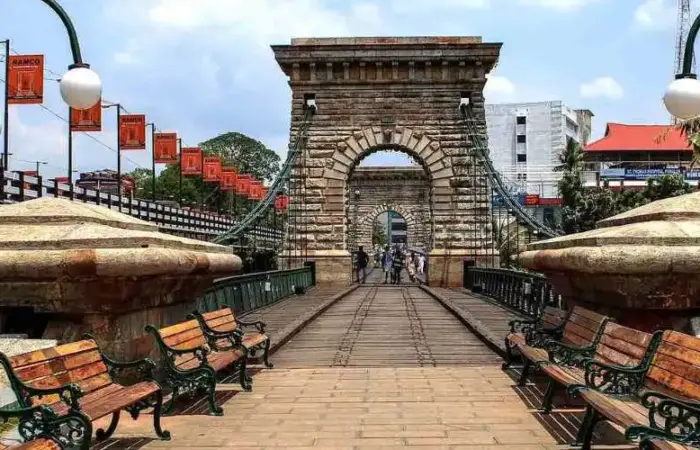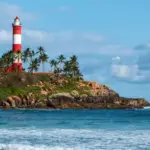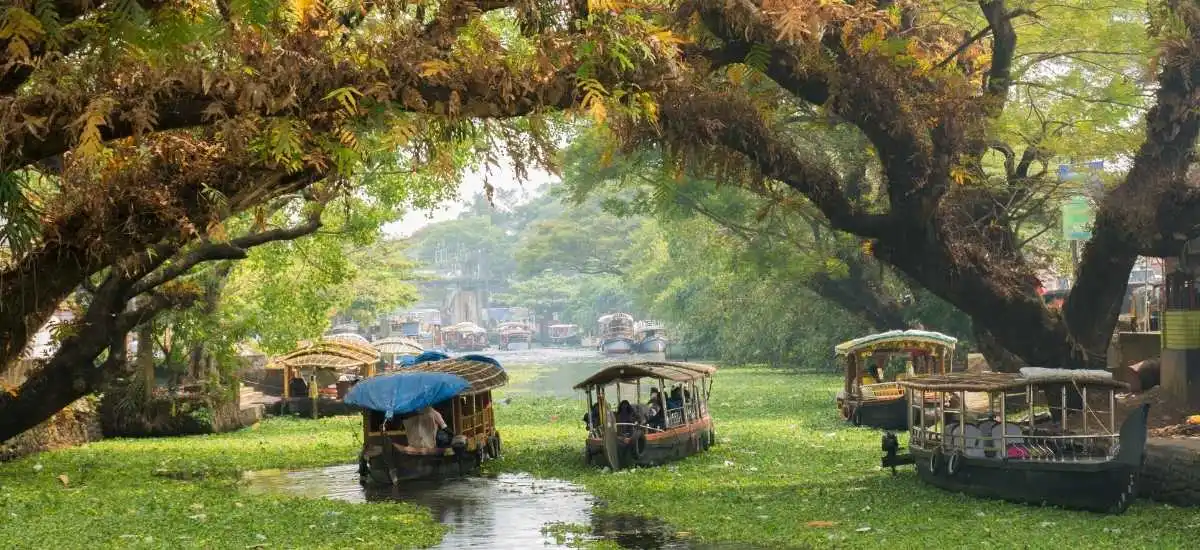
Kottayam owns its self-dignity as the ‘Akshara Nagari’ – the ‘City of Letters’ among the 14 districts of Kerala and stands as the glowing pride of the state. Kottayam is an incredible creation of God’s mighty work, with the lofty Western Ghats blanketed with emerald green on the East and the dazzling Vembanad Lake, along with the visually delightful vast stretch of paddy fields of Kuttanad on the West. Recognised as the land of letters, legends, latex and lakes, Kottayam is well-heeled with its contribution to print media and literature, places associated with many legends, extensive rubber plantations, as well as panoramic backwater stretches. The stunning beauty of Kottayam, as well as its various eye-catching attractions like the beautiful Meenachil river, etc, is referred to in the famous book of Arundhati Roy – “The God of Small Things”.
The picturesque waterfalls of Kottayam are worth a visit. The Marmala Waterfalls are a small waterfall with amazing beauty, but the journey to the waterfall along the rocky path through the rubber plantations is too hard. The Aruvikkuzhi Waterfall is another popular waterfall in Kottayam with excellent scenery, which is hidden behind the canopy of rubber trees. Aruvikachal waterfall, one of the tallest in southern Kerala, is located in Kottayam. The Kesari waterfall, Vadakkemala waterfall, Kazhukankulimali, and Vellamneekipara waterfall are the other waterfalls in Kottayam.
We all know that Keralites are very fond of elephants. And the other interesting feature is that the tallest elephants of Kerala are found in Kottayam. They are sheltered in a natural environment, and the place also provides an elephant safari for the tourists.
Also, many well-known churches of Kerala are situated in Kottayam. St. Mary’s Orthodox Syrian Church, popularly known as Cheriya Palli, is adorned with wall murals dating back to ancient times. The Valiya Palli that belongs to the Knanaya Jacobite Church is another famous church here. Puthupally St. George Church, the Vakathanam Palli, St Mary’s Jacobite Syrian Church in Manarcad, and Bharananganam St Mary’s Forane Church are some of the important pilgrimage centres in Kottayam.
Vembanad
The beauty of the verdant green state of Kerala is reflected in its numerous glistening, placid lakes that have attracted domestic as well as international travellers over the past decades. Vembanad Lake is the most prestigious and largest Lake in Kerala, recognised as India’s longest Lake and home to a bird reserve.
With a length of 83.72 Km and a width of 14.48 Km, the Vembanad Lake spans three districts of Kerala. And the most interesting trait of this Lake is that it is known by different names in these different districts. It is known as Punnamada Lake in Kuttanad in Alleppey district, which is famous for hosting the world-famous Nehru Trophy Boat Race. It is known as Kochi Lake in Ernakulam district, which boasts several groups of small, beautiful islands like Vypin, Mulavukad, Vallarpadam, and Willingdon Island, and it is known as Vembanad Lake in Kottayam district, which is an ideal spot for bird watching.
A saltwater barrier divides the Lake into two halves to prevent the intrusion of seawater, splitting it into brackish water and freshwater. Vembanad Lake is also known as the largest wetland ecosystem in India and was designated a Wetland of International Importance by the Ramsar Convention. It serves as a major source of fresh water for the state and also helps in the irrigation of a large part of the farming area of the state. On the eastern coast of the Vembanad Lake, the famous birder’s paradise known as the Kumarakom Bird Sanctuary is situated.
Houseboat cruise and holiday packages are offered by the famous Kumarakom tourist village situated near the Vembanad Lake. It is one of the best backwater destinations in Kerala, where you can enjoy the pleasure of a houseboat cruise, fishing, and bird watching, as well as admire the spectacular sunset at Vembanad Lake.
Periyar National Park
Serving as a repository of rare, endemic, and endangered species of flora and fauna, Periyar forms an absolute example of nature’s bounty. Periyar is not only a national park but also one of the 27 tiger reserves in India. Royal Bengal tigers, Indian Elephants, macaques and many other wild yet captivating creatures find their safe and comfy abode at the Periyar National Park.
The lush environment and the beautiful Periyar Lake of this National Park make their living luxurious. You can find here 49 species of mammals, 9 species of amphibians, 28 kinds of reptiles,22 species of fish, 265 species of birds, as well as 112 species of butterflies. Nilgiri langur, lion-tailed macaque, Golden Langur, Jungle cat, wild pig, gaur, Stripe-necked Mongoose, Bonnet Macaque, Indian bison, Indian wild dog, mouse deer, sambar, barking deer, etc, are some of the popular inhabitants of Periyar National Park. Quite a number of Nilgiri Tahr, which are the most endangered species of mountain goat, are protected here, but it is very difficult to spot them as they are very few in number.
Besides these various species of animals, Periyar National Park is particularly renowned for its elephants and tigers. The most fascinating part of this National Park is the pleasant, picturesque Periyar Lake at the heart of the sanctuary, which is actually an artificial Lake that dates back 100 years. Tropical evergreen forest with extremely thick tree cover, having an amazing height of up to 100-140 feet, shelters most of the valleys of Periyar, thus protecting the region from the scorching heat of the sun and providing a refreshing atmosphere.
Periyar also serves as an ultimate reservoir of many rich tribal settlements. October to February is regarded as the best time to visit Periyar National Park. And the Park opens daily at 6 AM and closes at 5 PM. Boat safari trips are also arranged at Periyar National Park for a duration of around an hour and a half.
Bandipur Tiger Reserve and National Park
Being one of the best-managed parks in India, Bandipur National Park has won a special place in India’s efforts towards the conservation of nature. Situated in the south Indian state of Karnataka, Bandipur Tiger Reserve and National Park are greatly admired for protecting varied wildlife living in different biomes in the dry deciduous forest. Bandipur National Park covers an area of about 874 square Km and is considered the region protecting the highest number of wild elephants in South Asia. Bandipur National Park, in company with Mudumalai National Park, Wayanad National Park and Nagarhole National Park, forms the Nilgiri biosphere reserve, which is one of the most extensive tracts of protected forest in India.
In olden days, Bandipur National Park served as the hunting grounds of the Maharaja of Mysore, and it was later, in 1974, that it was established as a forest tiger reserve under the Project Tiger. Bandipur Tiger Reserve and National Park were earlier known as Venugopala Wildlife Park. It houses tremendous numbers of wildlife species, including vulnerable kinds of animal species and varied mammals.
Grizzled Indian Squirrel, Bonner Macaque, Nilgiri Langur, Golden Jackal, Lion-tailed Macaque, Indian Palm, Giant Flying Squirrel, Indian Porcupine, Hanuman Langur, Bengal Fox, Eurasian Otter, Small Indian Civet, Indian Pangolin, Mongoose, Indian Hare, and Red are some of the wildlife of Bandipur National Park. Apart from various animal species, Bandipur National Park is also home to a great variety of timber trees and captivating flowering and fruiting trees and shrubs. And the entire region of the Park is drenched in greenery all around the vicinity.
October to January is regarded as the best time to visit this Park. Himavad Gopala Swamy Temple is situated at the highest peak in Bandipur National Park, known as Himavad Gopala Swamy Betta. The temple is dedicated to Venugopal Swamy (Lord Krishna) and was built seven centuries ago. The devotees have to trek through the hills to reach the temple. There is also a traveller’s bungalow on the hill, which belongs to the Ruler of Mysore.
Mararikulam
Mararikulam is a charming old-fashioned fishing village as well as a beach village in the Alleppey district. The main deity of the place is Lord Shiva, who is fondly known as Marari, and has contributed his name to the place. Mararikulam Mahadeva temple is a famous temple here. The place is situated only 14 Km from Alleppey, and it takes only an hour drive to reach Marari from the south of Kochi. This tiny village is quite famous among global travellers for its most tranquil and serene Marari Beach. Laid with golden sands and bounded by gorgeous palm trees.
Marari Beach provides a peaceful and laid-back ambience perfectly suited for those seeking relaxation and to unwind by the calming waters or laze around the shore. With pristine beauty and tranquillity, the Marari Beach serves as a heavenly retreat for honeymoon couples. In the National Geographic survey, the Marari beach was ranked as one of the world’s top five Hammock beaches. The beach is often calm and free from disturbances, but on weekends and holidays, it tends to become crowded. The huge Chinese nets used by the fishermen of Marari are quite a spectacular sight to watch, and you can also witness the fishermen sailing to sea in small boats and bringing in the daily catch when you visit the beach at dawn.
The large Chinese fishing nets that are hung along the seashore are another interesting feature of Marari Beach. Plenty of resorts, homestays and Ayurveda centres are available near the Marari Beach, which forms one of the main aspects of attracting tourists to this beach. Tourists can enjoy swimming, fishing, deep-sea fishing, cruising, take nice long walks and play outdoor games at this beach. Mararikulam boasts the oldest European church in India, St. Francis Church, a major tourist attraction here.


